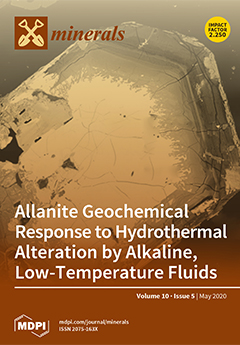The new mineral richardsite occurs as overgrowths of small (50–400 μm) dark gray, disphenoidal crystals with no evident twinning, but epitaxically oriented on wurtzite–sphalerite crystals from the gem mines near Merelani, Lelatema Mountains, Simanjiro District, Manyara Region, Tanzania. Associated minerals also include graphite, diopside, and Ge,Ga-rich wurtzite. It is brittle, dark gray in color, and has a metallic luster. It appears dark bluish gray in reflected plane-polarized light, and is moderately bireflectant. It is distinctly anisotropic with violet to light-blue rotation tints with crossed polarizers. Reflectance percentages for
Rmin and
Rmax in air at the respective wavelengths are 23.5, 25.0 (471.1 nm); 27.4, 28.9 (548.3 nm); 28.1, 29.4 (586.6 nm); 27.7, 28.9 (652.3 nm). Richardsite does not show pleochroism, internal reflections, or optical indications of growth zonation. Electron microprobe analyses determine an empirical formula, based on 8
apfu, as (Zn
1.975Cu
0.995Ga
0.995Fe
0.025Mn
0.010Ge
0.005Sn
0.005)
Σ4.010S
3.990, while its simplified formula is (Zn,Cu)
2(Cu,Fe,Mn)(Ga,Ge,Sn)S
4, and the ideal formula is Zn
2CuGaS
4. The crystal structure of richardsite was investigated using single-crystal and powder X-ray diffraction. It is tetragonal, with
a = 5.3626(2) Å,
c = 10.5873(5) Å,
V = 304.46(2) Å
3,
Z = 2, and a calculated density of 4.278 g·cm
−3. The four most intense X-ray powder diffraction lines [
d in Å (
I/I0)] are 3.084 (100); 1.882 (40); 1.989 (20); 1.614 (20). The refined crystal structure (
R1 = 0.0284 for 655 reflections) and obtained chemical formula indicate that richardsite is a new member of the stannite group with space group
. Its structure consists of a
ccp array of sulfur atoms tetrahedrally bonded with metal atoms occupying one-half of the
ccp tetrahedral voids. The ordering of the metal atoms leads to a sphalerite(sph)-derivative tetragonal unit-cell, with
a ≈
asph and
c ≈ 2
asph. The packing of S atoms slightly deviates from the ideal, mainly due to the presence of Ga. Using 632.8-nm wavelength laser excitation, the most intense Raman response is a narrow peak at 309 cm
−1, with other relatively strong bands at 276, 350, and 366 cm
−1, and broader and weaker bands at 172, 676, and 722 cm
−1. Richardsite is named in honor of Dr. R. Peter Richards in recognition of his extensive research and writing on topics related to understanding the genesis of the morphology of minerals. Its status as a new mineral and its name have been approved by the Commission of New Minerals, Nomenclature and Classification of the International Mineralogical Association (No. 2019-136).
Full article





